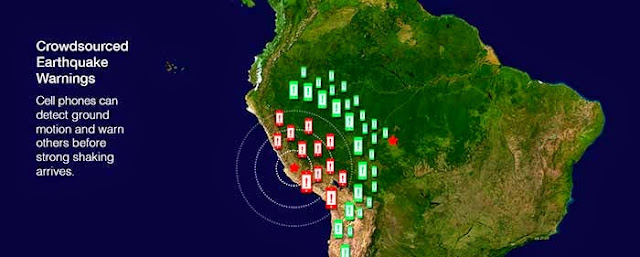Smartphones – Used as Initial Warning Signals for Earthquakes
According to a latest research, smartphones could now be used as initial warning signals for huge earthquakes. The built-in GPS sensors in the smartphones could help in detecting the quakes, giving several seconds of warning to people living in the vicinity which would be yet to be hit by earthquakes. The smartphone can detect big earthquakes with magnitude of 7.0 or larger as per the study published in the journal Science Advances.
The study indicate that the technique `crowdsourcing’, could be useful in sections of the world, which are vulnerable to quakes, in the absence of costly warning systems. With crowdsourcing observations from user’s smartphones, one can detect earthquakes, analyse and customize quake warnings which can be transmitted back to users. According to LiveScience, the system is still to be tested though a pilot project is scheduled later this year in Chile.
Geophysicist, Kristine Larson, of the University of Colorado, Boulder, states `what is really nice about this work is they are using sensors that people carry around anyway and it could be very useful’. Prior to an earthquake,a little bit of warning could help the people in seeking some help by taking shelter, nuclear power plants could take last minute precautions and natural gas utilities could shut down pipelines.
Crowd sourcing Earthquake Initial Warning System
Japan has an early warning system which relies on over 1000 seismometers all over the country thus saving lives during the magnitutde-9 Tohoku earthquake which hit in 2011. Mexico too has a similar system while another is under research in California. Though these systems could be time-consuming and expensive to install together with maintenance, cell phones could be an attractive choice in case of earthquake prone countries in developing world.
Earlier research of crowdsourcing earthquake initial warning systems have trusted on phones’ accelerometers that estimate the phone’s movement instead of GPS tracking locating the position of the phone with satellites. Though scientific GPS stations have been utilised in detecting earthquakes, the new study indicate that consumer devices with GPS could also be useful for crowd sourcing signals. Since most of the prevailing devices integrate GPS navigation which also includes vehicles, increasing amount of data could enhance the sensitivity of these efforts.
To comprehend if smart phones and other consumer devices could identify quakes with GPS, researchers tested the sensitivity of these devices. The cell phones tend to use a typically coarser method of positioning than the most sensitive scientific instruments that take advantage of more information that is encoded in the GPS signal.
Consumer GPS Devices – Identify Earthquakes of Magnitude 7 & Above
They studied the accuracy of cell phone GPS on shaking the phone, matching its recorded displacements with more accurate scientific device and monitored the phone for movement while holding it stationary and measured the chance for false alarms. The scientist believed that consumer GPS devices could identify earthquakes of magnitude 7 and above enabling probable warnings to people located away from the epicenter of the most critical earthquake, as reported in Science Advances.
Thereafter they tested the concept by using a computer stimulation of a magnitude-7 earthquake near Oakland, California on the Hayward fault, a probable area for future tremors which runs through the San Francisco Bay Area. On stimulating the typical response of cell phones shaking, they appraised the signals in cell phones near epicentre.
As per the researcher’s system, a quake activates a phone if the same and four adjoining devices tend to record instantaneous movements which could be greater than 5 centimetres. To clear out coincidences, the system tends to issue only an alert if more than 100 devices tend to see such causes.
Adequate Data –Improvement in Warning Potentials
Presuming data from 0.2% of population, less than 5000 people, the system was capable to identify the stimulated earthquake within five seconds a speed enabling a few seconds of warning prior to the strongest shaking started in San Francisco and 10 seconds before it started in San Jose, thus giving time for children to get beneath their desks and for trains to come to a halt.
They then tested their system with real data from Tohoku quake and used an array of 462 GPS stations all across Japan to estimate the data coming from cell phones. Though scientific instruments tend to be more precise than cell phones, they record lower quality data too which is same to data from consumer devices. With enhancement in technology and more devices integrate GPS tracking; this system could turn out to be more useful according to study author, Benjamin Brooks, an earthquake scientist in the U.S. Geological Survey in Menlo Park, California.
He states that `it is not really just about smart phones, it’s about all sorts of internet connected devices that have positioning associated with them – and think the numbers are going to be so large that one could be very liberal with criteria for using a specific device’. Detecting with cell phones could be difficult since users are always on the move though with adequate data, the system could depend on devices which are not in motion prior to the quaking thus improving the warning potentials.


No comments:
Post a Comment